A Paipo Interview with Guilhem Rainfray
June 21, 2011, updated July 31, 2013
Guéthary, France
E-mail interview by Bob Green
(Click on images for larger views)
Guilhem Rainfray makes and rides boards that are 2 to 3 times longer
than the average paipo. However, in his younger days Guilhem rode a
plywood "planky" as did his friends, including fellow
shaper Daniel Creignou.
It is difficult to find information about plankies so the recollections
of Guilhem and other surfers from the early days of French surfing
provide
a glimpse of an under-documented aspect of French surfing history.
|
1. What sparked your interest to start surfing? When and where was this?
The year was 1966. Before that, I had been spear-fishing quite a lot
and I was basically spending all my days at the beach in Guéthary
during the holidays, swimming, diving and spear-fishing. Then, about
1964, I started skateboarding and it led me to get interested in those
guys who were riding waves on boards (very few of them at the time). So
I tried to talk my parents into buying a surfboard but they thought
that it was very dangerous and they strongly forbid me to even try.
Trying to surf in Guéthary would have been too risky because my parents
might have seen me so what I did was to ride my bicycle from Guéthary
to Biarritz every day during the Summer of 1966 - pretending that it
was good physical training (and, believe me, it was). Then I would rent
a board from Jo Moraïz (who was one of the early French surfing
pioneers and owner of the first surf-shop in Biarritz) and that's how I
started surfing.
Guilhem Rainfray with Greek Maui Model boards, 1969-1970 and nearly 40 years later, left and right, respectively.
|

|
(Left) Guilhem
at age 14 or 15 with his Greek "Maui" Model surfboard, ca. 1969-1970.
Purchased third hand it was the second board he ever owned (after the famous
Barland/Rott).
(Right) Guilhem had so many great memories of his Greek Maui Model that
he contacted Greek asking if he would make another one. About 5 or 6
years ago, the Greek shaped a set of around 50 replica Limited Edition
Maui Model boards. Guilhem is the proud owner of the Limited Edition
Maui Model Number #01.
After receiving his new Maui Model, Guilhem posed for a photograph at the very same place as in the original 1970 photograph.
|

|
Photos and caption information courtesy Guilhem Rainfray.
2. Before I ask about your
first surfboard I believe you rode what was known in France as a
"surfy." What do know about the history of the use of the plywood surfy
boards? When and where were they first
surfed? Did these boards originate in France or did the design come from
elsewhere?
Actually,
we used to call these boards, "plankies," and I remember playing in the
shore breaks with those long before I started "real" surfing. From what
I remember they were very common on most beaches, but
they were considered as beach toys, just like inflatable mats. I am not
sure that they were originated in France. They might very well have been
"imported" by English people on holidays in France and then someone
decided to make them here. I sincerely don't know. What I know
is that they were on sale at most beach item shops along the coast.
3. When did you first ride a planky? Who made them?
I must have started riding a planky by 1962, or 1963. I was
seven or eight-years-old then, so it makes sense. As soon as I knew how
to swim, actually, and we did learn to swim quite early, my sister and
I. Recently I found an old swimming diploma dating back to August 1964,
mentioning that I had successfully swam 400 meters, so I could swim
before that date. Who made those things? As mentioned above I really
don't know. In the old French surfing magazine that I showed you,
there's an advertisement for a company called "Epiland" in Hossegor that
supposedly made them (or at least carried them), but that's about all I
know. (For historical information about planky board production and surfing in Southwestern Europe see appendix 1.)
Skimboard (Les Soucoupes) and planky (Le Surfy) advertisements in an early
French surf magazine, Surf Atlantique. Pictured below is a price list.
|

|
At the bottom of this advertisement it states, "Sur les petits rouleaux de bord, vous donnera vos
de premiers sensations de Surfer!" Roughly translated: "On
small
boards you will receive your first sensations of surfing!"
|
 |
|
Figures courtesy of Guilhem Rainfray and
Philip Zibin.
Source: Epiland [Advertisement]. (1964, June). Tout pour le surfer. Surf Atlantique, 1, 26-27. Epiland was a company in Hossegor, France. Surf Atlantique was a publication of the French Federation of Surfing (the publication run was limited to 3 or 4 issues).
4. Do you recall the dimensions or design of the planky?
I'd say roughly 100 x 40 cm, about 6 mm
thick, (40 x 16 inches, 1/4 inch thick); parallel rails,
square-tail, rounded or semi-pointed nose and this ski-like "spatula"
in the nose; and, made of plywood and varnished. I remember that some of
them had the Olympic rings as a logo. Below are photos of an original planky and a contemporary planky, produced for the Amstel Surfari in Summer of 2010. (For more information on the Amstel board see appendix 2.)
An
original planky (unvarnished) along with newer plankies. The wider
board with the curved tail was produced under the Amstel label.
|

|
|

|
Photos courtesy of Daniel Creignou.
5. Did many others ride these boards?
As I said before, it was a beach toy, much like Frisbees can be today. So most everybody used them at one time or another. At
least those familiar with waves (lots of tourists were not and they would look for places where few waves would break).
Original plankies.
|

|
|

|
Photos courtesy of Hervé Manificat (left) and the FreeWave website (right).
6. Which beaches were they mostly surfed and on what sort of wave were they best suited?
Shore breaks
almost exclusively. I can't remember anyone riding plankies in Guéthary
or Lafitenia for instance. But in Biarritz (especially the "Côte des
Basques"), Bidart and all the other
sand-bottomed beach-breaks, you would find kids (and maybe older guys)
riding them.
7. What technique was used to get out the back and catch waves when you didn't use swim fins?
Since we rarely used swim fins the plankies were best suited at places where waves would break in waist- to
chest-deep water so that you could just throw yourself into a coming
wave. Getting out the back of such small waves really was not an issue:
you would just jump over them with the planky in front of you.
8. Could you angle and turn the boards or
would they basically be ridden straight to shore? What technique was
involved in riding one of these boards?
Technically, they could be angled and turned,
but most of the time we would just be happy to ride the white water in
a straight line to shore. Although I am sure that some people must have
used them in a
more "performance-oriented" manner, riding the shoulder. Maybe even the
tube. But I don't remember seeing that.
9. How old were you when stopped riding the surfy and when did they generally stop being ridden in France?
I was eleven-years-old, but I would say that they
continued to be ridden for a few years after that. Then surfing really
took over. By 1970, I guess that there were not many around any more.
10. Your friend Daniel Creignou has a couple of "Jack's Bellyboards." Did you see many of these in the surf?
The only belly-board that I personally witnessed being ridden was
in Guéthary. One of the guys in our surf club had broken his board in
half and he had Barland (French surfboard maker) re-shape the
nose with a semi-circular inside cut to fit the surfer's belly better.
All the others that I saw were in ads in Surfer Magazine.
Two "Jack's Bellyboards" which made their way to France.
|
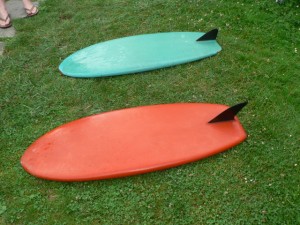 |
|
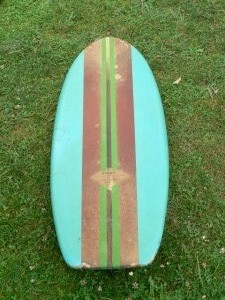 |
Photos courtesy of Daniel Creignou.
|
Daniel
Creignou boards at the French Vintage Surf Club's first meeting of
2010. From left to right: Jack's Bellyboard, wooden bellyboard and two
plankies.
|

|
Photo courtesy of Guilhem Rainfray.
|
11. What was the first stand-up board that you owned?
It was a big, about 10-foot, three-stringer Barland surfboard. When I finally got to
convince my parents that surfing was not that dangerous, I picked up
all the old things laying around in the attic and sold them (for
peanuts, of course…). Still, that provided a bit of money and I had my
father put up the rest. The next day my father told me that we would go to
Biarritz and try to find me a second-hand board at Jo Moraïz's
surf-shop. I was hopping with excitement, as you may guess; when we got
there, Jo wasn't at his shop but the clerk told us that he was at the
Côte des Basques beach and that we would find him easily, which we did.
Jo introduced me to "one of his best friends" who just happened to have
a "great second-hand Barland/Rott that he was selling to pay for a trip
to the states." The guy took me inside the Biarritz Surf Club, a
building at the base of the cliff where the club members could leave
their boards (this building was destroyed a few years later when the
cliff collapsed on it...) and he showed me his "great second-hand
Barland/Rott." It was a pale brownish color with just the 3 stringers
left visible and a rather square fin with the Barland/Rott logo on both
sides. The board actually looked pristine but for a tiny ding on the
left rail that the guy told me "had been professionally repaired."
Since I didn't know anything about surfboards (not even what they were
made of), he might as well have told me that it had belonged to the
President of the United States and I would have bought it.
My father didn't know anything about surfboards either and he said that
the board was pretty good-looking and we would take it. We paid 550
Francs for this, which was almost the price of a brand new board back
then...
I was an absolute beginner at the time, didn't know anything about
surfboards—not even what they were made of—and any board would have
looked great to me, so we basically bought the first one that was on
sale in Biarritz by some guy. I went straight to the surf club in
Guéthary, feeling so proud with my first surfboard, thinking that the
guys would all be jealous, and telling all the older guys, "Look at
that great surfboard that I just bought!!!" Instead, one of them
glanced at it and laconically said something like, "Hmmm... You should
scrape all that PAINT and see what's under, boy... ."
My friend Daniel Plisson and I spent the rest of the day scraping the
paint with a knife and sand-paper and the great-looking surfboard
finally showed that it was actually dinged every 4 inches or so under
the paint—just a giant ding from nose to tail. Talk about a great
bargain! Still great rides with this first board, of course. Your first
surfboard and the first girl you ever kissed are things never to be
forgotten.
"The carnage being done in
my parent's garden with my old friend Daniel Plisson (left). I stripped
my old Barland from its heavy fiberglass armor, and re-shaped the whole
thing with a heavy V-bottom."
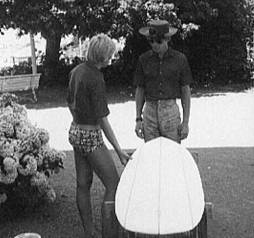
Photo and caption courtesy of Guilhem Rainfray.
I stuck vinyl flowers on most dings (remember, 1968, that was the
hippie thing going on...) and swore I would never buy another
second-hand board. This, too, led me to shaping my own.
12. How did you come to start making boards?
Very soon after I
got this old Barland board, the fin ripped out in a turn (it must have
been already fragile but I had not noticed it). Out of sheer luck, I
found it lying in the rocks
behind. I was thinking that my precious board was definitely through
but then the guys at the club told me that it could be repaired. One of
them even offered to do it for 50 Francs (that was a lot of money for a
kid in 1967…). That's how I first witnessed the magic of resin
impregnating that silvery-looking cloth and making it become perfectly
clear, then rock-hard. "The repair" was far from being professional. I
remember the guy trying to hold the fin upright while the resin was
curing and asking me, half-serious, "Would you rather have a board that
turns right or left?" But I'm pretty sure that this first use of
polyester resin (Oh God, what a wonderful smell…) was what led me to
inquire more and more into what surfboards were made of.
It was at this time, 1967, when the very first McTavish V-bottoms found
their way to France and pretty soon the shortboard revolution was on
its way, with any board over 9-foot becoming totally obsolete overnight.
Heavily V-bottomed boards were the rage. Since I had just bought myself
a board, I didn't have any money left to buy another one. Just like
many people at the time I decided to strip the old Barland, cut about
two foot off the tail and attempted to re-shape it into an 8-foot V-bottom
"mini." That was the beginning of a long journey…
"This ended into a very
hazardous first shape (and an even more hazardous first glass…) that
you can see on the left in this picture."

Photo and caption courtesy of Guilhem Rainfray.
That’s how I first started shaping. During the winter of 1969, Daniel
and I made a balsa 5-foot [surfboard]. The length was actually dictated
by the length of available lumbers. No foam blanks were available in
France at the time so balsa was our only choice. (Barland was the only board-maker, producing Clark
Foam blanks under license for his own use and not selling them to the
public.) We glued up the lumbers then
shaped the board with various tools that I found here and there. All
this in a room belonging to my parents in Paris, on the 8th floor of
the flat where we lived. When we started glassing the thing,
neighbors called the fire brigade because they were thinking of a gas
leakage somewhere (polyester smell was not well-known, either, at the
time) and we had a hard time explaining to the firemen what we were
doing… In the end, we were so proud of our production that we went
under the Arc de Triomphe to take pictures of it. (I have a picture
somewhere but cannot find it at the time… .)
The next summer, I had a talk with a guy named Joël Roux who was
starting to shape surfboards in Biarritz. Joël gave me an address in
Dax
where I would find foam blocks (not blanks). It was actually a small
factory where the guys were building isothermic trailers using big
polyurethane planks in metallic frameworks that were then covered with
fiberglass and resin. They would sell us blocks that were about 7 feet
long, 22 inches wide and 4 inches thick. The foam was brown and would
bump very
easily but at least it was foam. Daniel and I would go to Dax by train
(none of us had a driving license by then), bring back 2 to 4 foam
planks from the factory to the railway station, together with a big
resin drum and some fiberglass. We had to carry all that about 2 to 3
kilometers, then we would load everything in the [luggage] car of the
train and head back to Guéthary. Then from the station to the home of
my parents
near the church (you know the distance, you get the idea…) Since
the planks had no rocker in them, we would saw them in half, glue a
piece of plywood between the two halves and bend some rocker into them
while it cured (usually by loading the 20 kilogram drum of resin on
top…). You
may imagine what kind of [rocker] we would obtain with this method…
These were the first [real] boards that I shaped. Most of them were
[prototypes] for me and a few were for a small number of daring friends…
The next winter, in Paris, I found a company that would provide us with
the same kind of foam but in any thickness we wanted— so that it was
easier to shape some rocker in it. We ordered a big block that was 220
cm long, 150 cm wide and about 30 cm thick [about 87x59x12 inches] and I made three boards out
of it: two for friends and one for me out of what was left. At the
time, there was an advertisement in Surfer Magazine for a board made by Dick
Brewer for Reno Abellira called "The Disc" and it featured a ski-like
spatula in the nose. Thinking that Brewer was THE man to follow, I
shaped all boards like that.
The following photos are my best attempt at self-derision (I’m the one on the left)
|
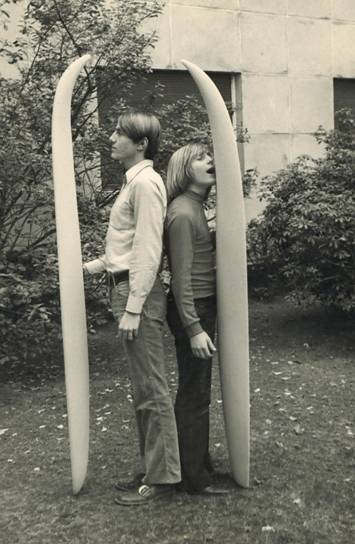
|
|

|
Photos and caption courtesy of Guilhem Rainfray.
From then on, things became a little bit easier because Barland started
to sell reject Clark blanks. They were full of bubbles and streaks but
they were real blanks with an outline and a rocker built in. Sometimes
even a stringer… At the time, Joël Roux agreed to glass some of my
shapes and that, too, was a huge progress because my glassing skills
were even worse than my shaping skills… Then, things slowly got better
and better. By the 1980s, I was producing more or less ridable boards…
In 1990, I officially became Guilhem Rainfray Surfboards (see photographs below).
Logos of Guilhem Rainfray Surfboards.
|
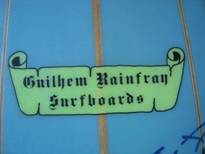
|
|

|
Photos and caption courtesy of Guilhem Rainfray.
Then, a few years later, the renamed company, Guéthary Surfboards (see photographs below).
Logos of Guilhem Rainfray Surfboards.
|
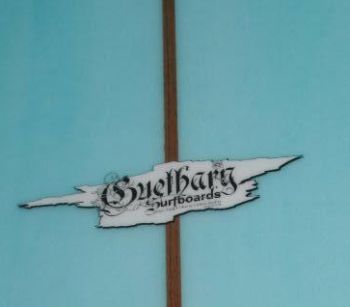
|
|

|
Photos and caption courtesy Guilhem Rainfray.
13. What type of board is needed for your local waves?
Guéthary is a very
special place. Even under 6-feet the wave still keeps its power all the
way from the outside to where it eventually dies. All the while it
keeps sucking water from the front
and since it's rarely very hollow there is always some slope at the
bottom of the wave where you can pick up speed. Not the kind of wave
that breaks top to bottom. You can think of it as a steamroller,
quietly and rather slowly crushing everything on its way for a long,
long ride. A very powerful but very easy wave: actually, the hardest
part is the take-off because its location keeps changing all the time.
You're sitting safely on the left (looking at the outside) and for
about ten minutes no wave comes. So you decide to paddle a little more
to the right. That's when you hear all the guys whistling and shouting
and suddenly everyone is paddling for his life towards the south-west
as the set of the day comes in from way outside (and way out to the
left). Taking all this into account, a good board for Guéthary has to
be a good paddler. There is really no shame in riding a 7'6'' or even
an 8', glassed heavy, with some "V" and/or belly that will find its way
through the chop easily. The power of the wave will provide all the
maneuverability you can think of. What you want is something that will
get into the wave early and allow you to outrace the "rogue" sets.
Pintails are welcome here to keep the board stable.
Guilhem with a 12'4" made to ride rogue sets and a glider.
|

|
|

|
Photos and caption courtesy of Guilhem Rainfray.
14. Any thoughts on the direction that surfboard manufacturing will take in the future?
Who can say what will happen? It's very tempting to say
that machines will kill all the "mystique" that was associated with
shapers. If you look at it now, anybody can decide to have his
surfboard brand, use some software program to design models (or just
copy someone else's), have a CNC machine cut them, underpay an
under-qualified worker to sand the cutter's grooves off, have the
"shaped" blanks sent to a glass shop and get back brand new boards with
his logo on them. Machines are not evil by themselves—only what you do
with them. Machines can copy much better than the best shaper can in
the same amount of time. But there was a time when nobody wanted a
copy. What was appealing in surfing and surfboard making was that it
went straight against the rules. Surfing meant freedom when the society
wanted all people to fit into the same mold and surfboard making was
just a personal relationship with a craftsman. You just didn't buy a
surfboard like you would buy a car. It was specifically made for you,
nobody else. I feel like surfing has been usurped and, of course, those
responsible for that are the ones who made money out of it. Actually,
my take on this is, "S'il n'en reste qu'un, je serai celui-là." ("If
only one is left, I'll be the one.") The one drawing templates with his
eyes on a piece of plywood, the one shaping with a power planer, the
one who glasses, puts fins on, sands, polishes his own boards. The one
for whom putting his logo on his boards actually means something.
Guilhem at 'work' on an experimental double-ender with a fin box at both ends.]

Photo courtesy of Guilhem Rainfray.
15. Any thoughts on surfing in general?
As said before. "Usurped." But it will still happen, from
time to time, this magic moment when you're out with only a few
friends, not necessarily with the best off-shore and glassy conditions,
and just having fun. That's what keeps me going.
Appendices
Appendix 1. Historical notes of Southwestern European planky surfing (paipo/bellyboard surfing).
A small number of Europeans, such
as Justin Hiriart, a Mayor of Sare, were known to have been to Hawaii
in the first decade of the 20th century. In the 1920s through the 1930s, there
are isolated accounts of attempts at surfing including Georges
Hennebutte with a cork aggregate surfboard; Hiriat and his daughter,
Françoise Hiriart Delanne; and, a Roederer who was a friend of Jean Saint
Jean. However, it wasn't until the early 1950s that wooden bellyboards
became popular. The inventive Georges Hennebutte (1912-1974), sculptor,
designer of the Swordfish (the L'Espadon, an inflatable boat), a surf
leash, life saving devices and many other inventions is credited with
developing the distinctive ski-lift nose of the planky. (Source:
Gardinier, Alain. 2004. Les tontons surfeurs: Aux sources du surf français. Anglet, France: Atlantica).
(Left) Georges Hennebutte and (right) Henri Poncini with a planky, 1958.
|
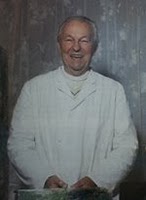
|
|

|
Photos courtesy of (left) Antony 'Yep' Colas and (right) from the 2007 Anglet exhibition courtesy of Antony 'Yep' Colas.
Plankies came to be produced commercially by Jacques (Jacky) Rott, who would
become a partner in Barland-Rott Surfboards and Sosthène Larcebeau, a
retired French Railways carpenter from Bayonne, France. These boards were
reported to be molded plywood (90 cm long and 40 cm wide, or 35 x 16
inches). (Source: Barland Surfboards [website]. (undated) Historique du surf en
France. Retrieved August 21, 2011, from http://cocyte.fr/barland/historique/.) Rott made his ply boards in a press, a method that found its way to Spain, where Marcelo Linaszoro made plankies.
(Below
left) Jacky Rott and fellow surfers, Cotes des Basques, ca. 1957.
(Below right) Rott with planky template and his planky, ca. 2012.
|

(Right) Jacques Rott was 80, when this photo
was taken by Philip Zibin, in October 2012. Rott was a cabinetmaker
from Dax, France, who made wooden bellyboards, known as plankies from
the 1950s. The blue board is his personal board from the 1950s,
and the other board is the original template which has never been in
water. His 5-ply boards were made in a press. Originally these boards
were flat. The nose lift has been attributed to another Biarritz,
France, local, the inventor Georges Hennebutte.
(Above) Photo by Joël de Rosnay, courtesy Antony 'Yep' Colas. (Right) Photo by Philip Zibin.
|
|

|
|
The planky was the first surfing experience of many of the first French
stand-up surfers in the late-1950s and into the 1960s. Joël de Rosnay and his friend,
Philippe Gerard, rode a planky from around 1950 to 1953 at Plage
Miramar, in Biarritz (Joël de Rosnay, personal e-mail, August 20, 2011)
and in a 1962 magazine article was described as an "avid belly-board and
body-surfer," while Michael Barland, the first manufacturer of
fiberglass boards in France, rode a planky on the Côte des Basques with
his friend, Henri Etchepare. (Source: Barland Surfboards. (undated
web page) Historique du surf en France. Retrieved August 21, 2011, from
http://cocyte.fr/barland/historique/.)
In 1997, Phillipe Puyo attempted to market an updated planky, the
FreeWave which was described as being made of a hi-tech material and
featuring a flexible rail.
FreeWave planky of the late-1990s.
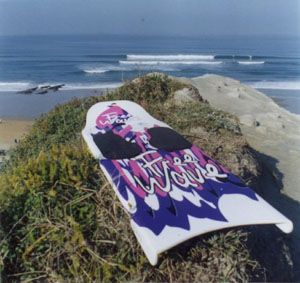
Photo courtesy of FreeWave.
Since that time, other incarnations have appeared such as Hidden Wood and the finned wooden
UhainaPo paipo boards. For more on plankies
see: Planky and bellyboarding in Europe.
Modern planky incarnations: paulownia Hidden Wood paipo and finned UhlainaPo paipo (2013).
|
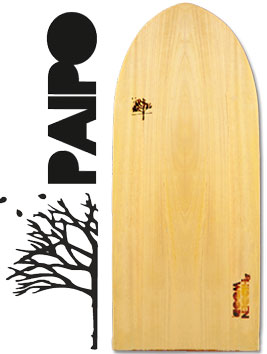
|
|

|
Photo courtesy of the Hidden Wood web-site and Bob Green. See also UhainaPo.
A popular French postcard in the 1960s and 1970s (see below) features a photograph of a stand-up rider and a paipo surfer.
The significance of this postcard within France is that the photograph
showed the possibilities of riding prone and was ubiquitous. More
people would have been exposed to prone surfing than in available
surfing magazines or surf films in the early days.
Guilhem always suspected Dr. Don James didn't shoot this in France. Rod
Rodgers notes that the postcard shown directly below appears to be a
color version of the black & white Dr. Don James photograph
(further below) that appeared in a book about surfing in 1965. The
paipo rider is most likely Jim Growney or John Waidelich and most
likely riding at Sunset Beach, North Shore, Oahu.
Carte postale moderne. Surfing sur l' ocean. Un surf et un planky.
[Translated: Surfing on the ocean. A surfboard and a planky.
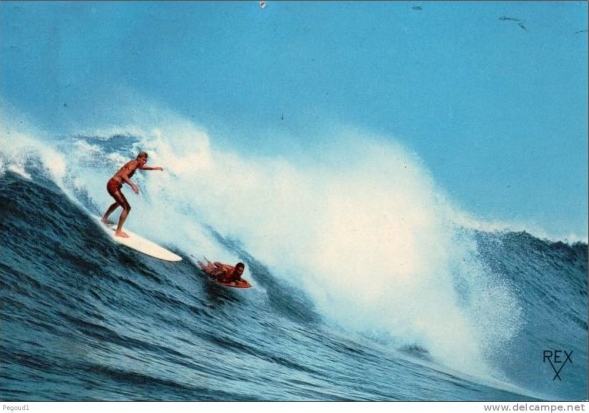
Figure courtesy of Philip Zibin. Post card title from www.delcampe.net, accessed on August 11, 2013.
Untitled photograph in the book Surfing, by H. Arthur Klein.

Source: Klein, H. Arthur. 1965. Surfing.
Philadelphia: Lippincott., p. 113. Courtesy of Rod Rodgers, MyPaipoBoards.org.
Appendix 2. The Amstel Planky Surfing Board.
Borja Garmendia, the builder of the Amstel boards, related to me in an email how he came to building the large number of planky boards for The Amstel Surfari:
It wasn’t until last year, when we found a stock of
these
classic planks at an old carpenter shop in the Basque Country. Of
course, the planks were piled and forgotten in a dark corner at the far
end of the workshop. After a few seconds of nostalgia and laughs,
remembering our little adventures with this great device, we considered
the possibility of recovering them and bringing them back to life.
Thus, we engraved the image of Surf Film Festival on them, using them
as part of our merchandising for The Amstel Surfari, a series of
activities and events along the
Cantabrian coast sponsored by our main partner. (Personal e-mail, Borja Garmendia to Bob Green, August 5,
2011.)
For more information on the Amstel planky, see the article, El Txampero, el autentico precursor del deslizamiento en nuestras costas, at the website, Pensando en blanco.
Amstel boards on the beach at The Amstel Surfari, ca. Summer 2010.
|

Photo courtesy of The Amstel Surfari.
|
Amstel boards and Linaszoro planky press.
|

|
|
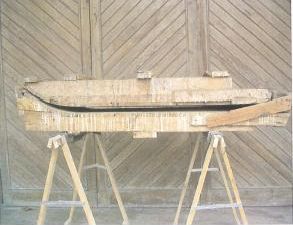
|
Photos courtesy Borja Garmendia and Lázaro Echegaray Eizaguirre.
In addition to these boards from the factory of Carpinteria Azkuee, the
molds and boards of Marcelo Linazasoro who began building bellyboards
after a trip to Biarritz have been documented in a book by Echegaray
Eizaguirre, Lázaro and Mikel Troitiño Berasategi. 2007. Lo que han
traído las olas (What the waves brought in a history of surfing in
Zarautz). Zarautz: Ayuntamiento de Zarautz, Dirección de Cultura. For further
information on Spanish plankies see Planky and bellyboarding in Europe.
Other Notes of Interest
Special acknowledgments: The assistance of Philip Zibin in providing
translations and sourcing French material is gratefully acknowledged,
as is the assistance of Joël de Rosnay, Zuberoa Andrés, Antony "Yep"
Colas, Alain Gonfaus Martinena, Florent Palangié and Hugo Verlomme.
Monique Beaufils of the Biarritz Muniicpal Archives provided
biographical information on Georges Hennebutte. Hervé Manificat provided figures and/or photographs.
|
|

































